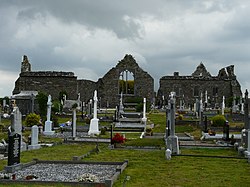Ballylongford
|
Ballylongford Béal Átha Longfoirt
|
|
|---|---|
| Village | |

Lislaughtin Abbey ruins and modern cemetery
|
|
| Location in Ireland | |
| Coordinates: 52°32′46″N 9°28′41″W / 52.546°N 9.478°WCoordinates: 52°32′46″N 9°28′41″W / 52.546°N 9.478°W | |
| Country | Ireland |
| Province | Munster |
| County | County Kerry |
| Elevation | 4 m (13 ft) |
| Population (2006) | |
| • Total | 406 |
| Irish Grid Reference | Q996449 |
Ballylongford (historically Bealalongford, from Irish: Béal Átha Longfoirt, meaning "ford-mouth of anchorage") is a village near Listowel in north County Kerry, Ireland.
The village is situated at the top of a creek of Ballylongford Bay on the tidal estuary of the River Shannon, close to Carrigafoyle Island and on the coast road between Tarbert and the seaside town of Ballybunion.
The farmland is suited to dairying and this is a mainstay of the local economy along with fishing and tourism.
Three kilometers to the north, on Carrigafoyle Island, stands the castle and anchorage commemorated in the name of the village. For centuries, Ballylongford shared the political, military and religious fate of the castle and the nearby Franciscan Lislaughtin Abbey.
Carrigafoyle Castle was built between 1490 and 1500 by Conchuir Liath Uí Conchuir (Connor Liath O’Connor) using a design borrowed from the Normans. In addition to fine windows and archways, it features a spiral staircase of 104 steps that visitors can climb today. The castle, now a listed National Monument, stands almost 30 m high and its battlements provide stunning views of the estuary and the monastic Scattery Island in County Clare. The O'Connors of Kerry held political sway from this strategic base which allowed them to “inspect” ships passing to and from the port of Limerick. Thus, “taxation” and smuggling were the main sources of income. The castle was fortified and the narrow spiral staircase ascends clockwise thus disadvantaging any attacker, particularly right-handed ones.
In 1580, during the Second Desmond Rebellion, the castle was defended by a garrison composed of some 70 Irish, Italian and Spanish troops, led by Captain Julian, an Italian. The Siege of Carrigafoyle Castle by Elizabethan forces under Lord Justice Sir William Pelham began on Palm Sunday. After two days, it was breached by cannon fire and taken, following which the surviving defenders were all hanged. The cannon breach is clearly visible to this day. Towards the end of the Nine Years War, taking advantage of the distraction of the English, Chieftain John O'Connor briefly re-occupied the castle only to be put out again in 1603 by George Carew, the Governor of Munster.
...
Wikipedia

